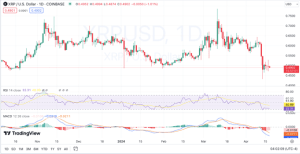Bitcoin price analysis shows the leading cryptocurrency grappling with market pressure, trading around $61,650. This comes after a 4% decrease in the last 24 hours, marking a phase of potential volatility as the digital asset sector reacts to broader economic signals. The ongoing strength of the U.S. dollar, buoyed by paused interest rate cuts, is diminishing the pull of riskier assets like Bitcoin.
Bitcoin’s price briefly dipped below the $60,000 threshold, marking a one-month low before witnessing a slight recovery, settling near $61,000. Despite courageous buying attempts to stabilize the market, the past week has been characterized by substantial losses, resulting in over $200 billion being wiped out from the digital asset market.
Key Factors Influencing Market Sentiment
The current bearish sentiment in the cryptocurrency market can be attributed to several factors. Firstly, there is a prevailing uncertainty regarding the impact of the upcoming Bitcoin halving scheduled for April 20. This event is expected to reduce mining rewards, potentially disrupting the supply dynamics of Bitcoin. Additionally, geopolitical tensions, particularly in the Middle East, have contributed to market volatility, as investors seek safe-haven assets amid geopolitical uncertainty.
From a technical standpoint, Bitcoin faces key support and resistance levels. The $58,500 mark serves as a critical support level, below which further downside movement may be anticipated. Despite breaching this support level briefly, Bitcoin has shown resilience, with buyers stepping in to prevent further decline. On the upside, overcoming the $62,000 resistance level is crucial for signaling a potential reversal in market sentiment. A sustained breach above this level could indicate a shift towards bullish territory.
Bitcoin Approaches Pivotal Moment, Resilience Tested at $60,000
In the 4-hour chart for Bitcoin (BTC), the price exhibits a rebound as it navigates above the $61,000 level, after experiencing a recent drop. The Bollinger Bands have stretched outwards, which often precedes a significant price move. Bitcoin’s price is currently challenging the middle band, suggesting that it is at a potential inflection point.
The Relative Strength Index (RSI), currently just above the 50 mark, indicates a neutral momentum. A push above the 60 level could signal increasing buying pressure, while a drop below the 40 level might suggest a return of bearish momentum.

The Awesome Oscillator (AO), showing red bars below the zero line, also conveys bearish momentum in recent trading sessions. However, the diminishing size of the bars suggests that the bearish momentum may be waning.
BTC’s immediate challenge is to maintain its position above the midline of the Bollinger Bands and attempt to break through the upper band. Traders will be watching if the price can hold its ground or if a further slide towards the lower band is in store. The interplay between the Bollinger Bands and RSI will be key to understanding BTC’s potential next move.
As Bitcoin continues to navigate through a period of heightened volatility, market participants remain vigilant for signs of stabilization or potential recovery. The next crucial juncture for Bitcoin’s price movement lies in its ability to either maintain support above $58,500 or break through resistance at $62,000. The outcome of these price levels will likely dictate the short-term trajectory of Bitcoin and the broader cryptocurrency market.


